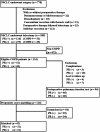Impact of pulmonary rehabilitation on postoperative complications in patients with lung cancer and chronic obstructive pulmonary disease
- PMID: 28696575
- PMCID: PMC5582456
- DOI: 10.1111/1759-7714.12466
Impact of pulmonary rehabilitation on postoperative complications in patients with lung cancer and chronic obstructive pulmonary disease
Abstract
Background: Given the extent of the surgical indications for pulmonary lobectomy in breathless patients, preoperative care and evaluation of pulmonary function are increasingly necessary. The aim of this study was to assess the contribution of preoperative pulmonary rehabilitation (PR) for reducing the incidence of postoperative pulmonary complications in non-small cell lung cancer (NSCLC) patients with chronic obstructive pulmonary disease (COPD).
Methods: The records of 116 patients with COPD, including 51 patients who received PR, were retrospectively analyzed. Pulmonary function testing, including slow vital capacity (VC) and forced expiratory volume in one second (FEV1 ), was obtained preoperatively, after PR, and at one and six months postoperatively. The recovery rate of postoperative pulmonary function was standardized for functional loss associated with the different resected lung volumes. Propensity score analysis generated matched pairs of 31 patients divided into PR and non-PR groups.
Results: The PR period was 18.7 ± 12.7 days in COPD patients. Preoperative pulmonary function was significantly improved after PR (VC 5.3%, FEV1 5.5%; P < 0.05). The FEV1 recovery rate one month after surgery was significantly better in the PR (101.6%; P < 0.001) than in the non-PR group (93.9%). In logistic regression analysis, predicted postoperative FEV1 , predicted postoperative %FEV1 , and PR were independent factors related to postoperative pulmonary complications after pulmonary lobectomy (odds ratio 18.9, 16.1, and 13.9, respectively; P < 0.05).
Conclusions: PR improved the recovery rate of pulmonary function after lobectomy in the early period, and may decrease postoperative pulmonary complications.
Keywords: Chronic obstructive pulmonary disease; lung cancer; pulmonary rehabilitation.
© 2017 The Authors. Thoracic Cancer published by China Lung Oncology Group and John Wiley & Sons Australia, Ltd.
Figures



Similar articles
-
[Influence of chronic obstructive pulmonary disease on postoperative lung function of lung cancer patients and predictive value of lung perfusion scan].Ai Zheng. 2009 Jun;28(6):642-6. Ai Zheng. 2009. PMID: 19635204 Chinese.
-
Video-assisted thoracoscopic lobectomy in non-small-cell lung cancer patients with chronic obstructive pulmonary disease is associated with lower pulmonary complications than open lobectomy: a propensity score-matched analysis.Eur J Cardiothorac Surg. 2014 Apr;45(4):640-5. doi: 10.1093/ejcts/ezt460. Epub 2013 Sep 19. Eur J Cardiothorac Surg. 2014. PMID: 24052605
-
Prevalence of and risk factors for postoperative pulmonary complications after lung cancer surgery in patients with early-stage COPD.Int J Chron Obstruct Pulmon Dis. 2016 Jun 16;11:1317-26. doi: 10.2147/COPD.S105206. eCollection 2016. Int J Chron Obstruct Pulmon Dis. 2016. PMID: 27366059 Free PMC article.
-
Outcomes of lobectomy on pulmonary function for early stage non-small cell lung cancer (NSCLC) patients with chronic obstructive pulmonary disease (COPD).Thorac Cancer. 2020 Jul;11(7):1784-1789. doi: 10.1111/1759-7714.13445. Epub 2020 May 6. Thorac Cancer. 2020. PMID: 32374491 Free PMC article. Review.
-
Segmental resection spares pulmonary function in patients with stage I lung cancer.Ann Thorac Surg. 2004 Jul;78(1):228-33; discussion 228-33. doi: 10.1016/j.athoracsur.2004.01.024. Ann Thorac Surg. 2004. PMID: 15223434 Review.
Cited by
-
Effectiveness of preoperative and perioperative pulmonary rehabilitation nursing program for the management of patients undergoing thoracic surgery: A systematic review and meta-analysis.Pak J Med Sci. 2024 Jul;40(6):1280-1286. doi: 10.12669/pjms.40.6.9259. Pak J Med Sci. 2024. PMID: 38952505 Free PMC article. Review.
-
Guidelines for preoperative pulmonary function assessment in patients with lung cancer who will undergo surgery (The Japanese Association for Chest Surgery).Gen Thorac Cardiovasc Surg. 2025 Jun;73(6):385-404. doi: 10.1007/s11748-025-02120-7. Epub 2025 Feb 19. Gen Thorac Cardiovasc Surg. 2025. PMID: 39969667
-
Effect of Pulmonary Rehabilitation on Postoperative Clinical Status in Patients with Lung Cancer and Chronic Obstructive Pulmonary Disease: A Systematic Review and Meta-Analysis.Evid Based Complement Alternat Med. 2022 Mar 28;2022:4133237. doi: 10.1155/2022/4133237. eCollection 2022. Evid Based Complement Alternat Med. 2022. PMID: 35600945 Free PMC article. Review.
-
Integrative Approaches to Minimize Peri-operative Symptoms.Curr Oncol Rep. 2021 Apr 28;23(6):73. doi: 10.1007/s11912-021-01051-9. Curr Oncol Rep. 2021. PMID: 33907909 Review.
-
Development of a real-time RGB-D visual feedback-assisted pulmonary rehabilitation system.Heliyon. 2023 Dec 14;10(1):e23704. doi: 10.1016/j.heliyon.2023.e23704. eCollection 2024 Jan 15. Heliyon. 2023. PMID: 38261861 Free PMC article.
References
-
- Licker MJ, Widikker I, Robert J et al. Operative mortality and respiratory complications after lung resection for cancer: Impact of chronic obstructive pulmonary disease and time trends. Ann Thorac Surg 2006; 81: 1830–7. - PubMed
-
- Brunelli A, Kim AW, Berger KI, Addrizzo‐Harris DJ. Physiologic evaluation of the patient with lung cancer being considered for resectional surgery: Diagnosis and management of lung cancer, 3rd ed: American College of Chest Physicians evidence‐based clinical practice guidelines. (Published erratum appears in Chest 2014; 145: 437.). Chest 2013; 143 (5 Suppl.): 166S–90S. - PubMed
-
- Sekine Y, Iwata T, Chiyo M et al. Minimal alteration of pulmonary function after lobectomy in lung cancer patients with chronic obstructive pulmonary disease. Ann Thorac Surg 2003; 76: 356–61. - PubMed
-
- Kushibe K, Takahama M, Tojo T, Kawaguchi T, Kimura M, Taniguchi S. Assessment of pulmonary function after lobectomy for lung cancer‐‐upper lobectomy might have the same effect as lung volume reduction surgery. Eur J Cardiothorac Surg 2006; 29: 886–90. - PubMed
-
- Cooper JD, Trulock EP, Triantafillou AN et al. Bilateral pneumonectomy (volume reduction) for chronic obstructive pulmonary disease. J Thorac Cardiovasc Surg 1995; 109: 106–16. - PubMed
MeSH terms
LinkOut - more resources
Full Text Sources
Other Literature Sources
Medical
Research Materials

